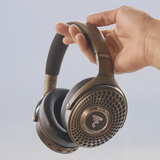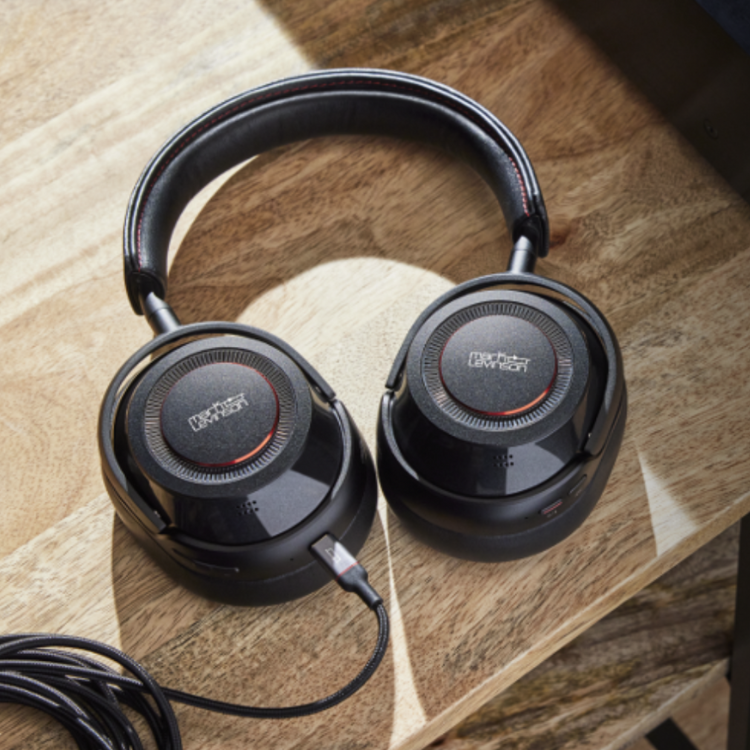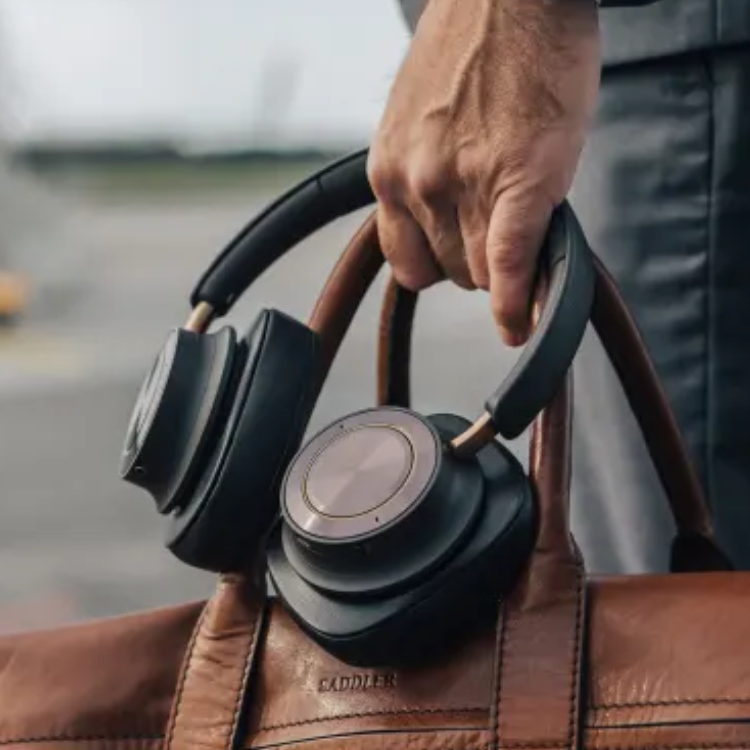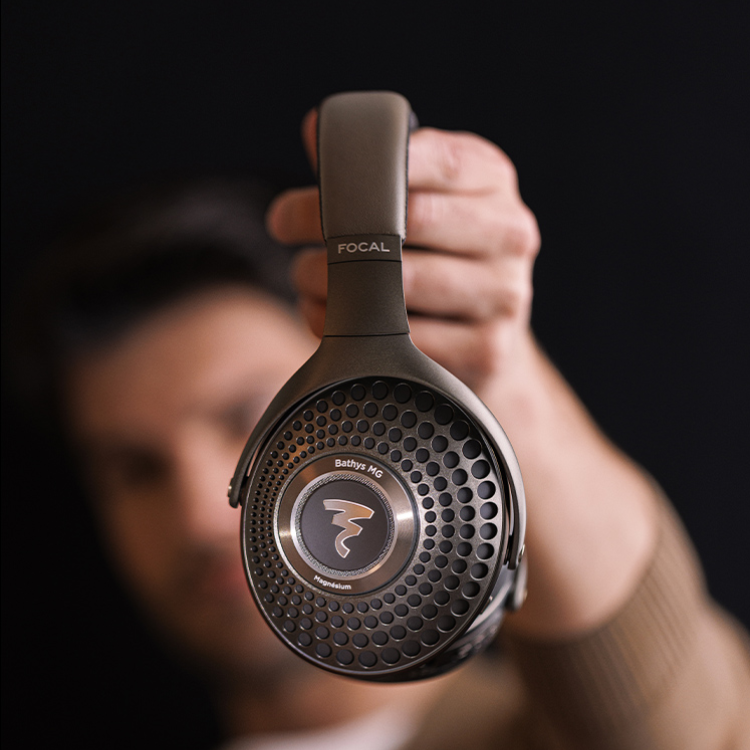Audiophile Wireless Headphones – An Oxymoron?

Many years ago, a friend and pulmonologist in Boston discovered he had a hidden talent for motorcycle racing, and I still remember some words he published in Motorcyclist magazine: “Most people don’t have the resources to own a high-performance racing car, but with motorcycles you can get that level of performance at a fraction of the price.” That’s exactly how I feel about headphones.
In the world of high-fidelity audio, a reference-quality system with matched components and room treatment can easily run $50K or more. But exceptional headphones? You can get stunning sound quality starting at not much more than $1000, which brings me to today’s topic: wireless headphones for audiophiles.
Are Audiophile Wireless Headphones Possible?
I will attempt to answer that question in this article and will take a closer look at three of the most advanced wireless headphones currently on the market. They are also among the most expensive. I will be looking at the Focal Bathys MG (MSRP $1499), the Dali IO-12 (MSRP $1750), and the Mark Levinson No. 5909 (MSRP $1099).
(Note that none of the three headphones in this comparison were manufacturer-supplied, and this review is completely independent.)
Bluetooth Basics for Audiophiles (Versions & Codecs)
Before we dive into the specifics, let’s look briefly at Bluetooth technology. For audiophiles, Bluetooth headphones have long been taboo, much more about convenience than audio quality. But, honestly, the sound isn’t terrible. For doing things around the house or going for a walk, it is immeasurably more convenient to not be tied to a cable, perhaps with a portable DAC, and we have all accepted lesser quality sound for ease of use. I have to laugh when I picture myself doing things around the house with the cable from Dan Clark Ether 2 headphones threaded through my shirt to a fanny pack holding my iPhone and Chord Hugo 2. Was it worth the quality of the listening experience over Apple AirPod Pros? Sometimes it was, sometimes not.
Bluetooth version 5.2 came out in 2020, and it was a major step forward for audio. With lower latency, stronger connectivity, and better audio quality, it paved the way for these new headphone models. Bluetooth 5.3 was released in 2022, but didn’t do much to improve audio performance, and because it is expensive to implement, for the most part shows up only in lifestyle brands. Of the three headphones we are discussing, the Mark Levinson uses the earlier 5.1, and the Dali and Focal both use 5.2.
Audio Codec is another factor, but I won’t say much about that here because codecs are a huge, huge topic that would require its own article. For this investigation, all my comparisons were with my Apple device as a source, which only offers AAC (Advanced Audio Codec). AAC is a kind of middle-of-the-road codec that doesn’t offer access to higher resolution listening. Even though all three headphones have better codecs on board, I was capped at AAC when listening with my iPhone. However, my main interest herein is the experience of listening to music on these three headphones and how they sonically compare to each other. I don’t believe using the AAC codec was a handicap for my conclusions.
Fit, Finish, and Comfort
Let’s begin by looking at the physical aspects of each, starting with the Mark Levinson model.
Mark Levinson No. 5909 — Build & Comfort
Starting with the Mark Levinson 5909, I was disappointed in the fit and finish. The ear cups are not very compliant, and are also the smallest of the three headphones. If you have larger ears, the 5909 could feel more like an “on-the-ears” headphone. The combination of the harder leather cup and tight fit, along with a stronger clamping pressure, made them the least comfortable of the three headphones, and I struggled with long listening sessions.
The headphones are solidly built, but I didn’t like the plastic shell on the earpieces, which felt a little cheap. I also wasn’t confident in the fragile-seeming buttons, which don’t have the solid, satisfying ‘click’ that the other two headphones have. What they did get right is the headband, however, which is very soft, premium-feeling leather, and the most comfortable of the three headphones, and there is no doubt that they are solidly made and durable.
In terms of accessories, the headphones come in a fairly large box, with a nice carrying case that feels like soft leather. A nice touch inside the case is an attached zippered pouch that holds all the cables and accessories. The Levinson comes with audio and USB cables and a number of adaptors.
Dali IO-12 - Build & Comfort
The Dali IO-12 are perhaps the most comfortable, with soft leather earpads that are the largest of the three headphones, and have a squarish shape that is more forgiving fit-wise and accommodates larger ears. The clamping pressure is also just about perfect. One small gripe is that the depth of the ear pads is about ¼” less than the others. I don’t have large ears, but I felt the top of my ears touching the inside of the baffle. This didn’t bother me, but for someone with larger ears, this might be an issue.
The buttons have a great feel and a solid, confident click. There isn’t an app for the IO-12, so all control is done physically on the headphones. I do like that all the controls are easily accessible on the earpieces themselves, and the volume control is easily accessed on the outside of the earcup. Still, I think Dali could have improved the functionality with options that could be accessed with an app, such as multiple noise cancellation modes (the ANC is either on or off).
The case is serviceable, with flapped and elastic compartments for cables, and comes with audio and USB cables, as well as a number of adaptors. The zipper felt flimsy to me, and I don’t expect it will hold up to on-the-go use.
Focal Bathys MG — Build & Comfort
The Focal Bathys MG has achieved a perfect fit balance in my opinion, with excellent clamping force and lovely soft leather ear cups that are more compliant than the original Bathys. I found the original Bathys a little uncomfortable for long listening sessions, but I had no such trouble with the updated MG. The ear cups sit between the Mark Levinson and Dali in terms of size, but I can’t imagine they wouldn’t be comfortable across the board. The increased depth of the ear cups is an improvement over the IO-12, but with the very compliant ear cups you may feel your ear touch the baffle. Again, this wasn’t an issue for me, but it could be if you have larger ears and are bothered by contact with the baffle.
The Focal includes USB and audio cables, but no adapters. It has a mesh elastic pouch on the inside of the lid, and a small, open area for cables. The construction quality is good, but I think the case will be prone to getting dirty. Still, this is my favorite of the three cases because it is streamlined and low profile, making it the easiest to throw in a bag or backpack when you are on the go. Also, I appreciated that the headphones came in a recycled clamshell package, making the MG the least package-heavy of the trio. I know that audiophiles love to save boxes (I have many in the closet), but I like the thoughtfulness Focal brought to the table with this simple packaging.
Noise Cancellation (ANC) at a Glance
Before I talk about the sound character of these headphones, I’d like to mention that the active noise cancellation (ANC) on all three was excellent. I preferred the Focal and Mark Levinson to the Dali for ANC because the former two each have three modes, versus just on/off with the IO-12. I found it useful to have a sort of “lite” ANC when I was in a coffee shop that wasn't particularly noisy, and a full ANC when, say, shopping in a supermarket.
I did notice a difference in the sound with all three when the noise cancellation was on, though less so with the Focal in the soft mode. The full ANC sound on all models doesn’t seem to breathe as much and feels a little compressed, with the overall frequency spectrum slightly attenuated. However, this is not a problem because if you are in a noisy environment, you need ANC, which provides a better listening experience, and in my opinion, the trade-off is worthwhile. I do think that Focal has a slight edge in the implementation of noise cancellation, especially with the effective soft mode.
Sound Impressions & Listening Notes
Now let’s move on to the good stuff and talk about the sound of each headphone.
Mark Levinson No. 5909 — Sound

The Mark Levinson has a tight and forward presentation, with a fairly narrow sound stage. There is considerable clarity, particularly in the upper mids, and this can make them a little fatiguing. One of my favorite recordings to use when evaluating headphones is Yosi Horikawa’s Spaces. It has everything: simplicity, complexity, openness, density, and a huge range of tonal variance.
The 5909 did pretty well with Spaces, especially with the enhanced bass response activated in the Mark Levinson app. The wild soundstaging of that recording benefits from clarity, and the Levinsons did a decent job of giving each instrument its own space, but there wasn’t enough soundstage when the music became more complex. The headphone also did okay with Adele’s “Easy On Me”, with the openness of just her voice and piano, but the smaller sound stage took away from the character and power of her voice. The headphones also struggled with music that has a more mid-focused presentation, such as “Little Booker" from John Abercrombie’s Open Land, where the 5909 seemed to compress the overall soundstage, and Kenny Wheeler’s brilliant opening melody on the trumpet getting a little lost. I think this was also because the Levinson seemed at times to have over-hyped upper mids and trebles.
Anouar Brahem’s “The Astounding Eyes of Rita” fared well at the beginning with the solo oud and then later during the oud improvisation, but when all the instruments were present the 5909 didn’t have enough soundstage to handle the wide and expansive music. This is exactly what I found with the more dense tracks in Spaces, where the sounds felt like they didn’t have breathing room. When I upped the intensity of the music with Rage Against The Machine’s “Wake Up”, the headphones simply weren't able to convey the intensity of the music.
All in all, I found the 5909 the least pleasurable to listen to. Its emphasis on full-spectrum clarity and detail made music seem a little flat and forward, without allowing room for the natural dynamics of music.
Dali IO-12 — Sound
Of the three headphones, the Dali IO-12 had the widest presentation, with excellent detail and soundstaging. This may be due to their patented Soft Magnetic Compound (SMC) system, which reportedly reduces distortion in the voice coils by lessening the effect of shifting magnetic fields (per Dali, the SMC eliminates eddy currents and hysteresis). It is the same technology they used in their $70,000+ KORE flagship speakers.
Not surprisingly, the sound in the IO-12s was less forward and seemed to have more room to breathe. There is a strong lower mid presence in this headphone, and a full bass response. Listening to Rakim’s track “King’s Paradise” was an experience that was felt as much as it was heard. Oddly, the ‘hifi’ setting was considerably more balanced with bass-heavy music because the enhanced bass setting seemed to smear the low end. But in hifi mode, Anour Brahem’s bassy oud sounds and the electric bass ostinato on “The Astounding Eyes of Rita” were given all the space they needed, and were tight and focused.
On the other hand, the bass boost worked on “The Revelator” by Gillian Welch, a very mid-focused track, due to the frequency of her voice, but also the fact that Dave Rawlins plays an old plywood archtop (which sounds fantastic but doesn’t have a lot of dynamic range). Another place the IO-12’s absolutely shone was in a solo Bill Frisell recording of “St. Louis Blues” with his Anderson archtop. In the end, I just had to experiment with the bass boost mode, and it worked sometimes, and didn’t other times.
In contrast to the 5909, the Dali fully handled intense music like the Rage Against The Machine track, but I felt the soundstage was a little compromised with music that is both intense and highly complicated, such as the Juilliard Quartet’s recording of Elliott Carter’s string quartets.
When I think about how to describe the character of these headphones, I struggle to avoid the word ‘warm’ because it is really a vague term. Instead, I’ll say that the Dali has a strong presence in the lower mids, which opens up naturally as frequencies increase, with good coherence across the entire human hearing range when in hifi mode. They don’t have the razor-sharp clarity of the Mark Levinson, but the detail is there, and they are less fatiguing as a result. I had no issues listening to these headphones for hours.
Overall, I found the Dali IO-12 to be a very comfortable, well-balanced headphone that was easy to listen to. It excelled at reproducing a variety of kinds of music, with an open sound and great soundstaging. I didn’t always feel that the lower frequencies were in perfect coherence with the full spectrum of frequencies, but I honestly didn’t notice this during casual listening. The clarity and detail were not as acute as the 5909, which meant I could listen to the Dali for hours without fatigue.
Focal Bathys MG — Sound
If the Mark Levinson 5909s have a smaller sound stage with perhaps a bit too much detail for many types of music, and the Dali IO-12s have a full frequency response with a rich lower mid and bass response that, with some music, seems a little out of balance with the upper frequencies, the Focal seemed to be perfectly situated between the two.
I had a couple of issues with the original Bathys model, and while I enjoyed listening to them, I found that for critical listening, I remained a little too aware of those flaws. Specifically, the upper midrange felt stinted, and that made the overall sound stage a little flat for me, and not particularly wide. Not terrible, but it felt like a compromise I wasn’t happy with when I was listening for the pure pleasure of music. For podcasts, books, and listening while doing other things, I think the original Bathys are perfectly fine.
Another issue with the original Bathys was that, while the clamping pressure was comfortable, I felt that the compliance of the earcups made the Bathys hard to listen to for long periods, and when moving around, the seal was easily compromised.
The MG upgrade seems to have solved those issues completely. The original Bathys has a 95% aluminum / 5% Magnesium driver, which is heavier and less dynamic than the pure magnesium driver of the MG, and I assume that is part of the reason the original Bathys struggled at frequencies between about 1000 Hz and 1500 Hz.
Moreover, Focal must also have done some careful tuning work because the midrange on the newer model is spectacular, and to my ears, the best of the three headphones. It has a better balance of clarity and detail, with richer lower mids than the 5909 or the IO-12, and better coherence from bottom to top. While I can’t say this for certain, I think Focal has done a better job of phase correcting the bass frequencies because they are seamlessly integrated into the entire sound presentation. One other improvement is that the MG provides a 3 dB change with each click of the volume control, which is a significant improvement over the original Bathys' 5 dB per click.
For the first few days of listening, I was in ‘normal’ mode because I hadn’t downloaded the app. When I did get the app, I explored the EQ section and then clicked on ‘dynamic.’ According to Focal, this mode is an EQ preset that references the so-called ‘Harman’ tuning.
The Harman tuning curve was created in the early 2010s by a group of researchers who studied listener preferences in headphone sound. As I understand it, they wanted to create a tuning that yielded the most natural-sounding response curve for headphone listening, and one that emulated listening to speakers in a room. One thing that is worth mentioning here is that the Harman tuning is not preferred by everyone. In fact, some people report that it can make vocals a little over-hyped and out of balance. Everyone is different, though, with different-shaped ears, different ear canals, and different preferences. So my experience of the Bathys MG Dynamic mode is unique to me, and you may feel differently.
In the normal mode, I found the dynamic response and coherence in the MG to be similar to the Dali in hifi mode. I felt the two headphones were really neck-in-neck in terms of quality of sound, and I personally would have to flip a coin to decide my favorite. But in dynamic mode, I think the MG moves out ahead to be the best-sounding headphones of the three. The best way I can describe my experience is that all the positive things I experienced in normal mode were just a little bit better in dynamic mode.
I am not suggesting that there is a huge difference between the normal and dynamic mode, and to my ears, the overall sonic signature of the headphones is consistent. Both modes have just the right amount of detail, with a fantastic midrange, excellent coherence, and a lovely, wide soundstage.
Going back to Yosi Horikawa’s Spaces in dynamic mode, I found more space between the sounds than either the Dali or Levinson, and the superb soundstaging sounded great with even the most complex sections of the music. The detail was on par with the 5909, but a little smoother, and the coherence that the Dali had in spades was even more refined in the updated Focal. It’s like you took all the best qualities of the 5909 and IO-12, removed the negatives, and created the new Bathys.
The upper frequencies have great detail, but also–and I really hate to use this word–there is a sweetness to the way they bloom, and the fine detail and clarity don’t tire out your listening experience. The wide sound stage, similar to the IO-12, opens up the music to give every instrument the space it needs. Frankly, the Focal occasionally reminded me of open-back headphones. Anour Brahem’s “The Astounding Eyes of Rita” in dynamic mode was pure pleasure. The deep nuances inherent in the music arrived to me perfectly balanced, articulate, and if I closed my eyes, I almost felt I was listening to live music.
For me, listening to Elliott Carter’s “String Quartet #3” by The Juilliard Quartet in one go was a clear indication of how special these headphones are. There was plenty of space to allow careful listening without feeling overwhelmed. I sometimes think Elliott Carter’s four string quartets contain all of human experience, and listening to them on any headphones is a challenge because of the intensity and range. I then followed the Carter quartets with the open and refined intensity of Pavel Steidl playing J.K. Mertz’s Variations Migonnes. All of the subtleties and nuances of Steidl’s playing, the sound of his fingers moving on the strings, and his breathing, created a heightened experience of the piece.
Verdict: The Finest Wireless Headphones for Audiophiles
For me, the Focal Bathys MG stood out as the best listening experience, with the Dali IO-12 a little behind. The MGs came out on top simply because, to my ears, they did the best job of allowing me to fully experience the music I was listening to. So, the question I set out to explore has an answer; yes, both the Focal and the Dali headphones fit comfortably in the category of audiophile headphones. I do think the Mark Levinson 5909, especially at over $1000, falls a little short of the mark, and for the sound it offers, something like the original Bathys might be a better choice at a much more attractive price.
Can the Focal Bathys MG replace speakers, or even wired headphones? Of course not. But they have a unique place in the hifi world, and I wouldn’t hesitate to own either of these headphones for the pure pleasure of listening to music. In fact, I may pick up a pair of Bathys MG in the near future!
Postscript: Bathys MG in Wired vs. Bluetooth (What’s Next)
I felt strongly when I started this project that I wanted to focus on just the sound of the wireless headphones, and not compare them to other wired headphones, nor compare the wireless and wired performance. However, for those of you who are interested, over the course of getting to know these three headphones, I have come to think a comparison to wired is worth doing (the Dali and Focal headphones are really that good). I’ll be writing another article in the near future that will explore the Focal Bathys MG in the context of both wired versus Bluetooth use, and MG versus some of my favorite wired headphones.
Here is a little teaser: I did listen briefly to the MGs in wired and DAC mode. Both were excellent, but my initial impression is that I preferred Bluetooth. We’ll see if that holds up to more careful listening. Look for that article in the coming weeks.
Hear More. Learn More. Love Your System More.
Join thousands of music lovers who get weekly guides, expert insights, and exclusive offers from The Music Room.


